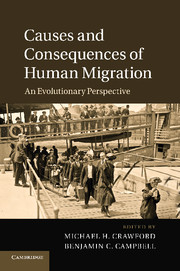Book contents
- Frontmatter
- Contents
- Contributors
- Preface
- 1 Perspectives on human migration: introduction
- Section 1 Theory
- 2 Genetic evidence concerning the origins and dispersals of modern humans
- 3 The biology of human migration: the ape that won’t commit?
- 4 Evolutionary basis of human migration
- 5 Evolutionary consequences of human migration: genetic, historic, and archaeological perspectives in the Caribbean and Aleutian Islands
- 6 Kin-structured migration and colonization
- 7 The role of diet and epigenetics in migration: molecular mechanisms underlying the consequences of change
- Section 2 Geography and migration
- Section 3 Overview
- Index
- References
5 - Evolutionary consequences of human migration: genetic, historic, and archaeological perspectives in the Caribbean and Aleutian Islands
Published online by Cambridge University Press: 05 December 2012
- Frontmatter
- Contents
- Contributors
- Preface
- 1 Perspectives on human migration: introduction
- Section 1 Theory
- 2 Genetic evidence concerning the origins and dispersals of modern humans
- 3 The biology of human migration: the ape that won’t commit?
- 4 Evolutionary basis of human migration
- 5 Evolutionary consequences of human migration: genetic, historic, and archaeological perspectives in the Caribbean and Aleutian Islands
- 6 Kin-structured migration and colonization
- 7 The role of diet and epigenetics in migration: molecular mechanisms underlying the consequences of change
- Section 2 Geography and migration
- Section 3 Overview
- Index
- References
Summary
Introduction
This chapter provides a broad overview of migration, its history and causes, as well as its geographic and genetic influences on two human groups living in radically different areas of the world – the Caribbean and Aleutian Islands. Prehistoric colonization and settlement by both Garifuna and Aleuts, severely disrupted by forced relocation from outside (British, Russian, or American) during the eighteenth and nineteenth centuries, resulted in substantial cultural and genetic transformations in both groups. The Garifuna forced migration stimulated a unique evolutionary success story along the coast of Central America, while the Aleut populations experienced highly asymmetric patterns of gene flow from Russian colonists and Scandinavian and British fishermen.
What is migration?
Migration is the relocation of people from one geographical region of the world to another region. Movements of culturally and/or linguistically homogeneous migrants were traditionally termed diasporas (Brubaker, 2005). For example, the dispersion of Jews from the Middle East into Babylonia in the sixth century BC, followed by further migrations into Europe and Asia, has been characterized as the Jewish diaspora. The terminology was further broadened to include other forced movements and population relocations, such as the African diaspora (Alpers, 2001). These migrations result in the fission of the parental populations, founder effects, reproductive isolation, exposure of genomes to new environments, and gene flow – if the region was previously inhabited.
- Type
- Chapter
- Information
- Causes and Consequences of Human MigrationAn Evolutionary Perspective, pp. 65 - 86Publisher: Cambridge University PressPrint publication year: 2012
References
- 1
- Cited by



